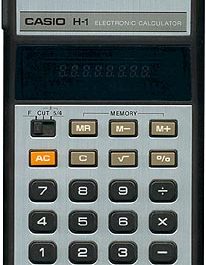
The Casio Mini (CM-602) calculator, introduced in 1973, was one of Casio’s earliest pocket-sized calculators. Solidly built with a horizontal format, this basic four-function calculator featured a two-piece black textured plastic case with wrap-around metal plates, giving it a robust feel. Measuring approximately 153mm x 81mm x 37mm and weighing 240g excluding batteries, it was powered by four AA batteries or an optional AC adapter.

The calculator sported a 6-digit blue VFD display with a unique representation of zero, using only the lower half of the digit. Although limited to six digits, a display shift key allowed for 12-digit precision. The large, long-travel hollow keys provided a satisfying typing experience.
Manufactured by Casio Computer Company Ltd. in Japan, the CM-602 was constructed with two main boards: a CPU board (6D-1 B) housing the keyboard assembly and a power board (Fuji MDP-0606 A60447) connected via 12 strong wires. Notable components included a Hitachi HD32154P CPU, a Toshiba T3144 IC, and an NEC LD8088 VFD tube.

Logic:
- The (C) button cleared the last entered number, and a second press (or (=)(C)) cleared the entire calculator.
- Overflow on number input was suppressed, ignoring the seventh digit.
- An overflow error displayed all zeros and was not recoverable.
- Divide by zero errors were ignored, allowing calculations to continue with the zero result.
- There was no constant function for any operation.
- Negative numbers were represented with a “-” in the digit to the left of the number, limiting negative values to five digits. (However, the author’s example did not display this sign correctly.)
- The shift key (>) showed the least significant six digits for the product or quotient of a multiplication or division calculation.
- A switch enabled a two-digit financial input mode, where keying in (1)(2)(3) resulted in the input of “1.23”.
Despite its early design and limited logic, the Casio Mini CM-602 was a pioneering effort in the development of pocket-sized calculators, showcasing Casio’s commitment to compact and robust construction.


